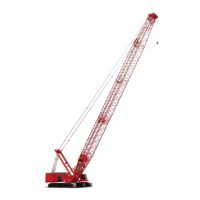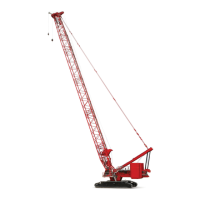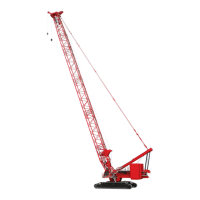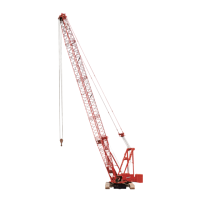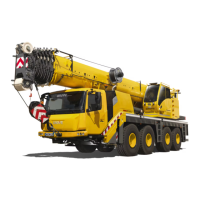Manitowoc Published 12-10-19, Control # 258-05 4-43
MLC90A-1/MLC100-1 OPERATOR MANUAL SETUP AND INSTALLATION
Deactivating/Activating a Block-up Limit
Switch
If the block-up limit switch is not used at the following
locations, the corresponding limit switch must be deactivated
to prevent the block-up limit fault from coming on during
operation.
• Lower Boom Point
• Upper Boom Point
• Jib Point
See Figure 4-26
.
To DEACTIVATE a limit switch, proceed as follows:
1. Remove the locking flag (2, View A) from the storage
slots in the limit switch (1).
2. Slip the locking flag (2, View B) over the actuator cable
(3).
3. Engage the locking flag (2, View C) with the limit switch
(1).
4. Release the actuator cable (3).
5. Disconnect the block-up limit chain (4) and weight from
the actuator cable.
To ACTIVATE a limit switch, proceed as follows:
1. Pull down the actuator cable (3, View D) and remove the
locking flag (2).
2. Install the locking flag (2, View E) in the storage slots in
the limit switch (1).
3. Connect the block-up limit chain (4, View E) and weight
to the actuator cable (3).
NOTE The optional second block-up limit switch at the
lower boom point is equipped with a shorting plug as
shown in Figure 4-22 on page 4-36
.
If the optional second block-up limit switch is not
used, it can be deactivated either by:
• Performing the above procedure.
• Attaching the shorting plug to the electric cable.
This will allow the limit switch to be removed and
stored in the tool box.
WARNING
Two-Blocking Hazard
Two-blocking is the condition in which the load block or
the hook-and-weight ball runs into the boom or jib point
sheaves.
Two-blocking can result in failure of the sheaves and
wire rope, possibly causing the load to fall.
If a block-up limit switch is deactivated, it is the operator’s
responsibility to stop load the block or the hook-and-
weight ball before it contacts the boom or jib point
sheaves.

